The journey to Italy somehow sealed the return to (some sort of) normality. I visited Italy with two friends of mine, and for a few carefree days, we went on a road trip around Tuscany. Apart from the stunning landscape, the journey was all about moving from place to place, drinking wine, and eating pasta. Today, seen from a distance, this journey feels like a Tuscan dream.
Although I tried to be as lazy as possible, I knew I had my Polaroid SX-70 in my bag. The days in Italy were sunny, and this, of course, meant perfect conditions for shooting polaroids. However, this old aperitivo ritual that strikes me whenever traveling to Italy returned. And while I had the intention to roam the streets and shoot photos, I always thought: “But first, an Aperol Spritz.”
Despite the distractions, I shot two SX-70 films while road-tripping in Tuscany. Not good, but not terrible, I’d say: all three of us rediscovered ourselves in Italy and realized how much we missed being on the road. The pandemic was still everywhere, but we could finally enjoy the landscape, the people, and life.
Once again, the polaroids served their purpose and gave an analog touch to the journey. And today, I’m glad to show you the images I got through the lens of the SX-70.
*Some of the links are affiliate links. It means that if you buy something, I might earn a small commission at no additional cost to you.
What you’ll see in the Polaroid Diaries: A Tuscan dream

I had three SX-70 films in my bag, but I only used two of them, as I already wrote. Nevertheless, I’m pleased with the results, and some of the photos look really good. The light in Italy is sweet, and I have already used some images in my polaroid zines.
Therefore, in this edition of the Polaroid Diaries, you’ll see 14 photos from my journey. The remaining two pictures of the second film didn’t make it to this diary for a good reason. One turned out completely black, while the other was never shot in Italy. I actually finished the film in Athens.
So, before we start, here are the places you’ll see in this edition: San Marino, Arezzo, San Gimignano, Siena, and Florence. Last but not least, if you want to read more about these places, I’ll link to the dedicated travel guides I wrote.
Let’s start.
Polaroid Diaries: A Tuscan dream with the SX-70
Although San Marino technically doesn’t belong to Tuscany, we decided to include it in our itinerary. We thought it might be a nice stop on our way down to Tuscany from Bologna. And indeed, this micronation surprised us with its natural beauty and vibe. So, the first photo from the Italian road trip was shot in San Marino, in one of its iconic towers called Guaita. The image is taken late in the afternoon, but I think it looks good.

The following morning we left San Marino and headed to the city of Arezzo. The town belongs to Tuscany, and it’s an excellent introduction to the area’s vibe. We drove through colorful hills and valleys and reached Arezzo in the afternoon. Unfortunately, it was very cloudy in Arezzo, which translated to a polaroid struggle. However, Arezzo is magnificent, and I thought of using the SX-70 twice.
The first image is from the Piazza Grande, one of the most stunning Italian squares. If you have watched La vita è Bella by Roberto Benigni, you probably remember how beautiful this piazza is. Due to the lack of light, I thought of shooting a photo of people having lunch in the square; unfortunately, a landscape photo wouldn’t work under these conditions. So, here’s the picture:
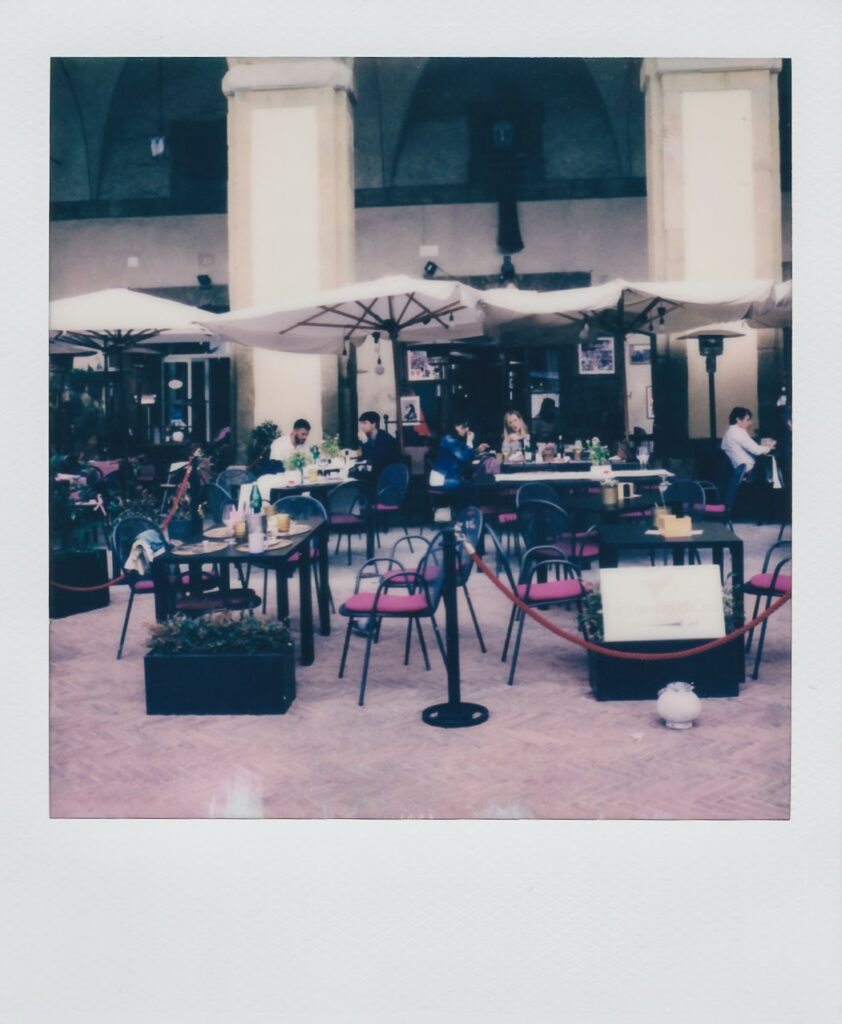
Then, we came across a bodega, and since the light kept being absent, I thought of shooting a detail. The sign reads “Cantucci Vinsanto,” and it references the famous dessert of Tuscany. It consists of a glass of Vin Santo wine and a selection of almond biscuits, which you dunk in the wine.

After leaving Arezzo, we continued towards Siena, with a stop in Pienza. I must admit that Siena didn’t meet our expectations. While the city is stunning in terms of architecture, we failed to connect with it. Siena felt a bit distant and not as lively as other Italian cities. However, it was an excellent base for our Tuscan road trip, and it was sunny throughout our stay.
In the photo below, you can see the Torre del Mangia in Piazza del Campo.
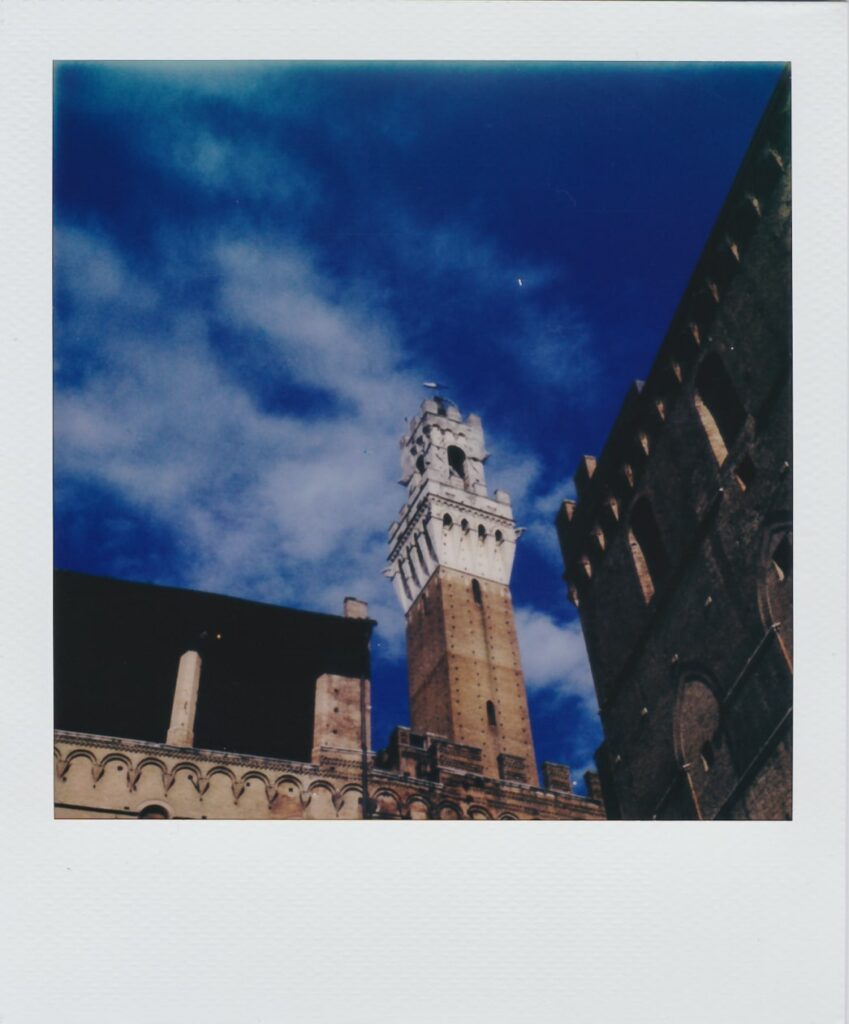
As I said, Siena’s light was impressive, and I thought of shooting a photo of my friend Chris. So here’s the polaroid I took close to Piazza del Campo.

Since we decided to have a Siena as a base, we started traveling around the region. The landscape is fantastic, and you’ll constantly see places like this one:
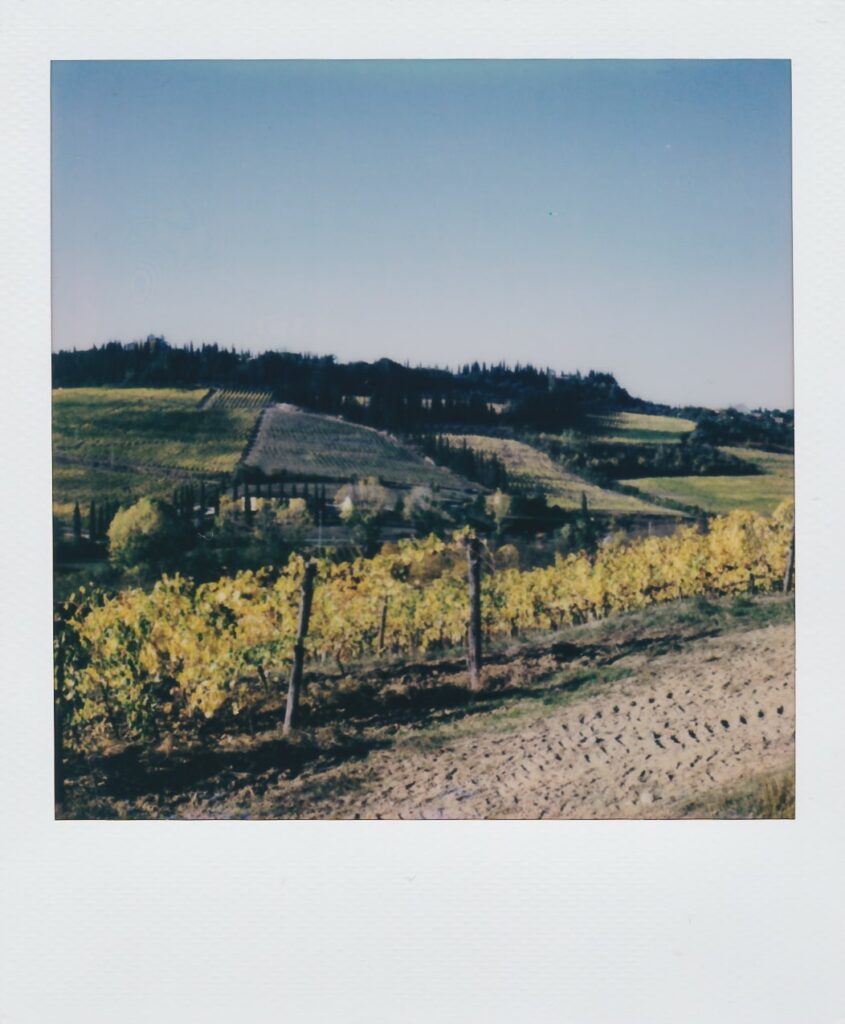
Or even like this one:
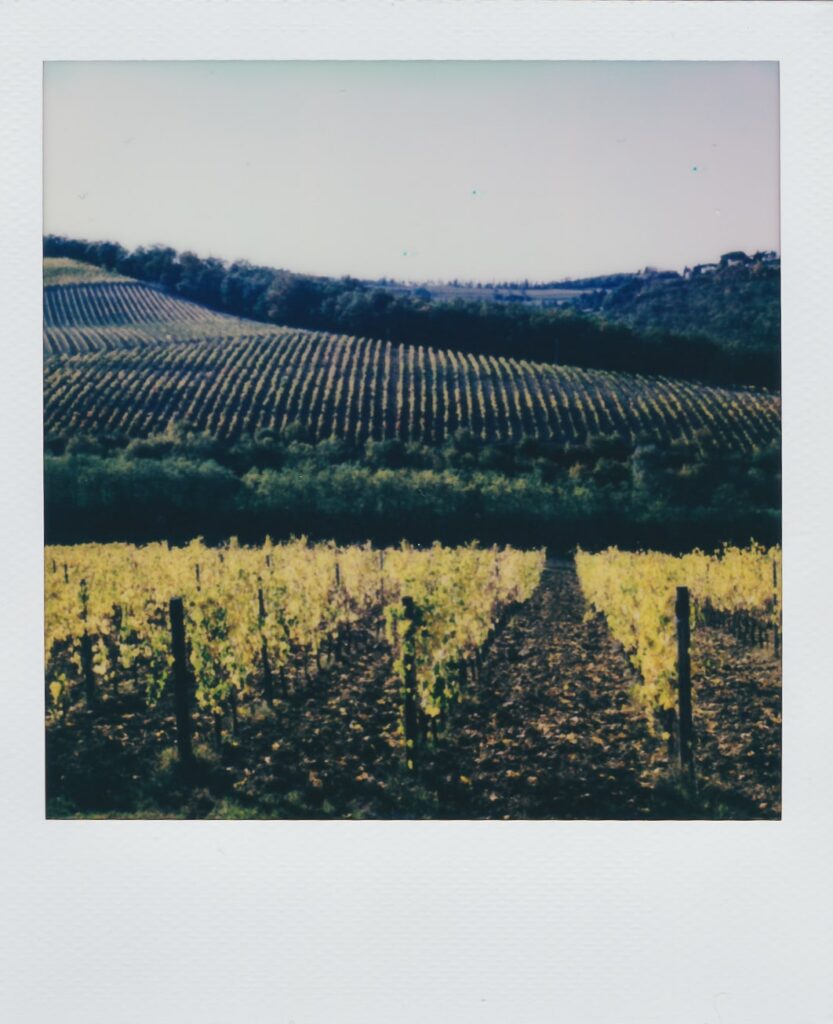
At one of these stops, I shot a photo of my friend Marianna. This time though, I didn’t go for a staged portrait. Instead, I wanted to have a more spontaneous picture. And here’s what I got.

The Val d’ Orcia is a beautiful valley extending in the region around Siena. We drove several times through its cultivated hills, which are famous for their wine. I thought of shooting a polaroid, but unfortunately, it doesn’t do justice to what you see. However, I believe you can get a good impression of its size and terrain.
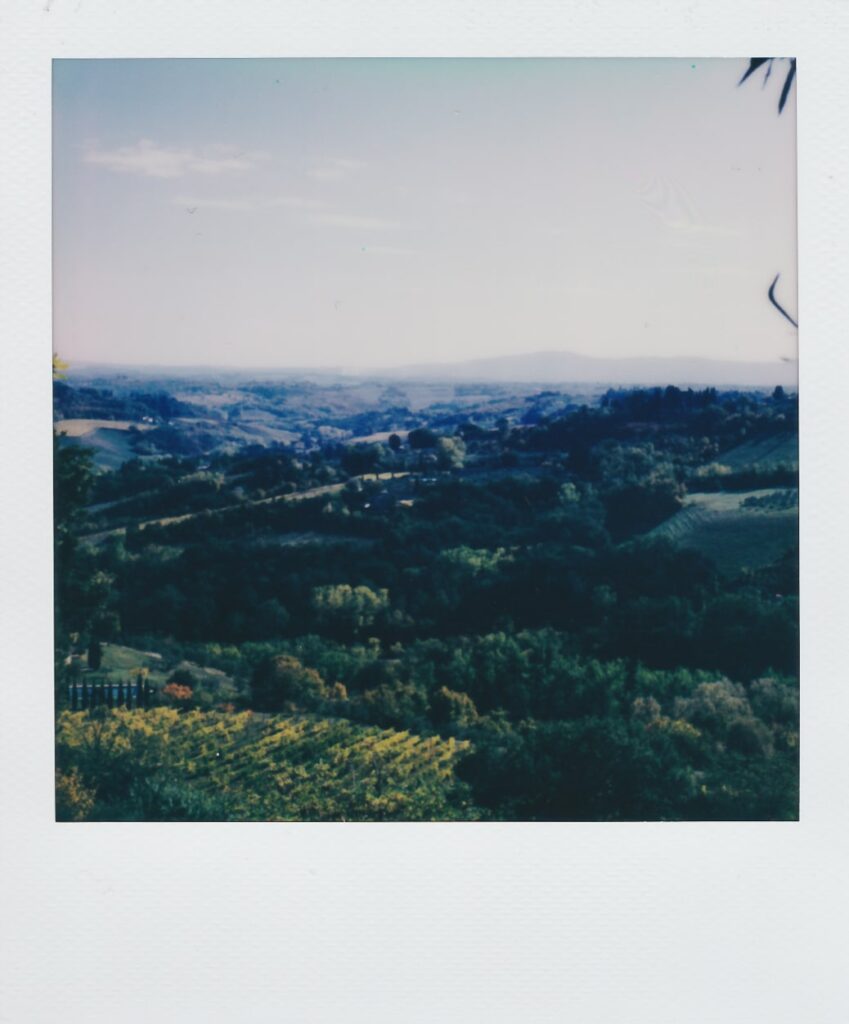
And then, of course, we stopped at San Gimignano. This small town is one of Tuscany’s highlights. People often refer to it as Medieval Manhattan due to its towers. The skyline of San Gimignano is occupied today by 14 medieval towers; however, back in its glory days, it had 72.
San Gimignano’s most famous spot is undoubtedly the Piazza della Cisterna. The square’s name derives from the underground cistern (Cisterna) built back in 1287. Here’s how it looks.
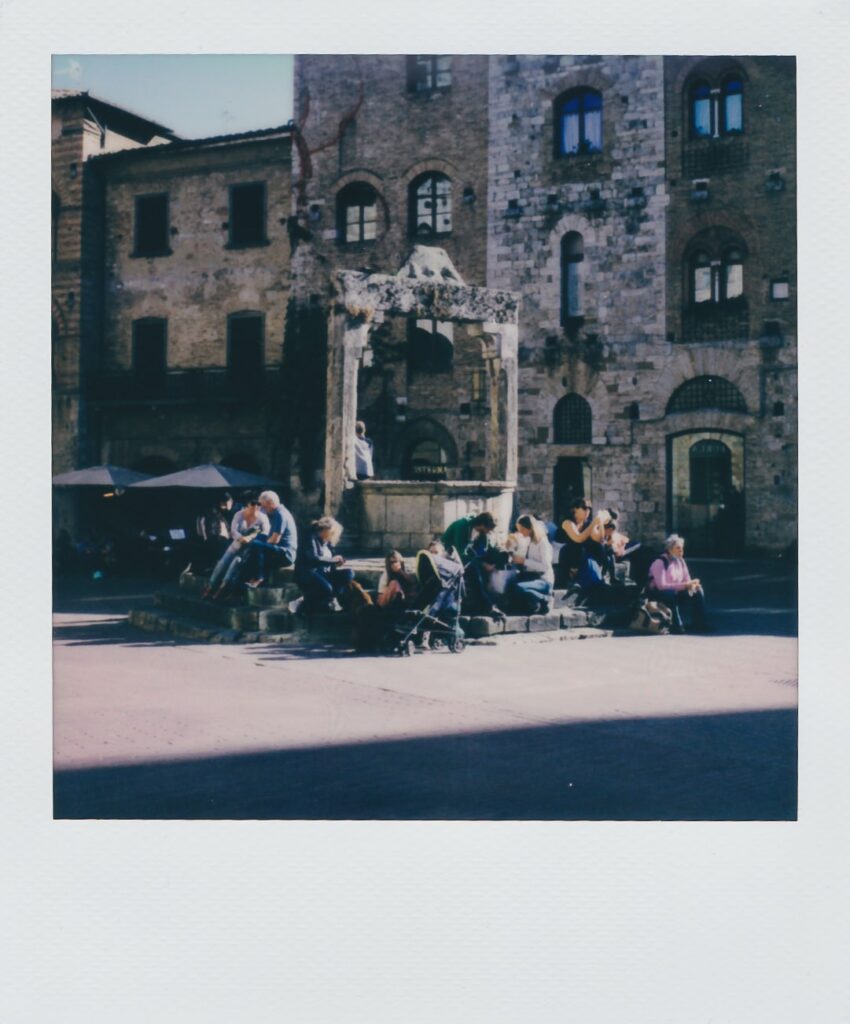
As I often do while carrying the SX-70, I searched for a colorful flower. I’m so bad at recognizing flowers, but I always want to photograph them. And here’s one from San Gimignano.

No journey to Italy can be complete without a visit to the cradle of the Renaissance. Florence is Italy’s most beautiful city, and we couldn’t, of course, ignore it. It was a short stay in Florence; honestly, the city needs weeks if you want to explore it fully. It wasn’t my first time in Florence, but it was actually the first time I had a polaroid camera when visiting it.
That said, I took three polaroids in Florence. The first one is from the Ponte Vecchio and the Uffizi Museum. The famous bridge is in the shadow, but the Uffizi really shines.
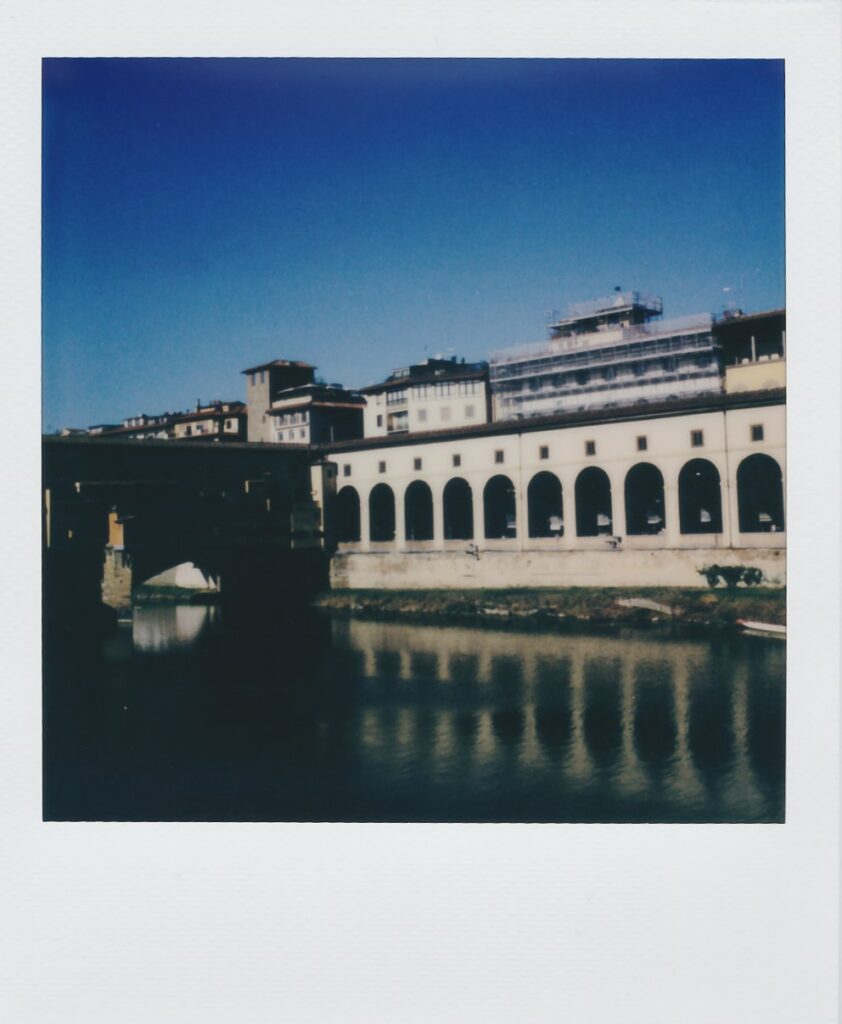
The next photo is from the famous Duomo of Florence. Unfortunately, the afternoon light was very intense, and it was hard to raise the camera and get a good photo. But here’s the Duomo polaroid anyway:
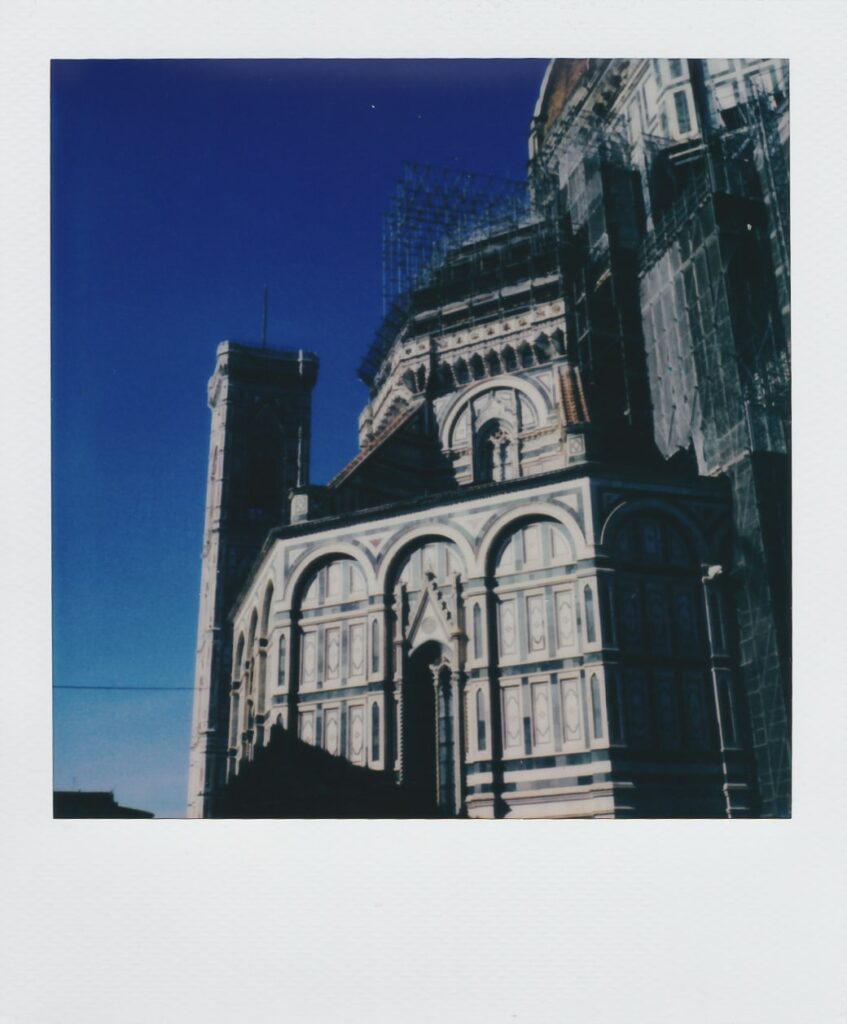
Finally, the last polaroid of this Italian diary is a random moment, once again, from Florence. While the city seems like an open-air museum, it also has local life. So instead of shooting one more landmark, I thought of catching a street scene. Not that far from the Duomo, I came across a carousel and a kid running around it.
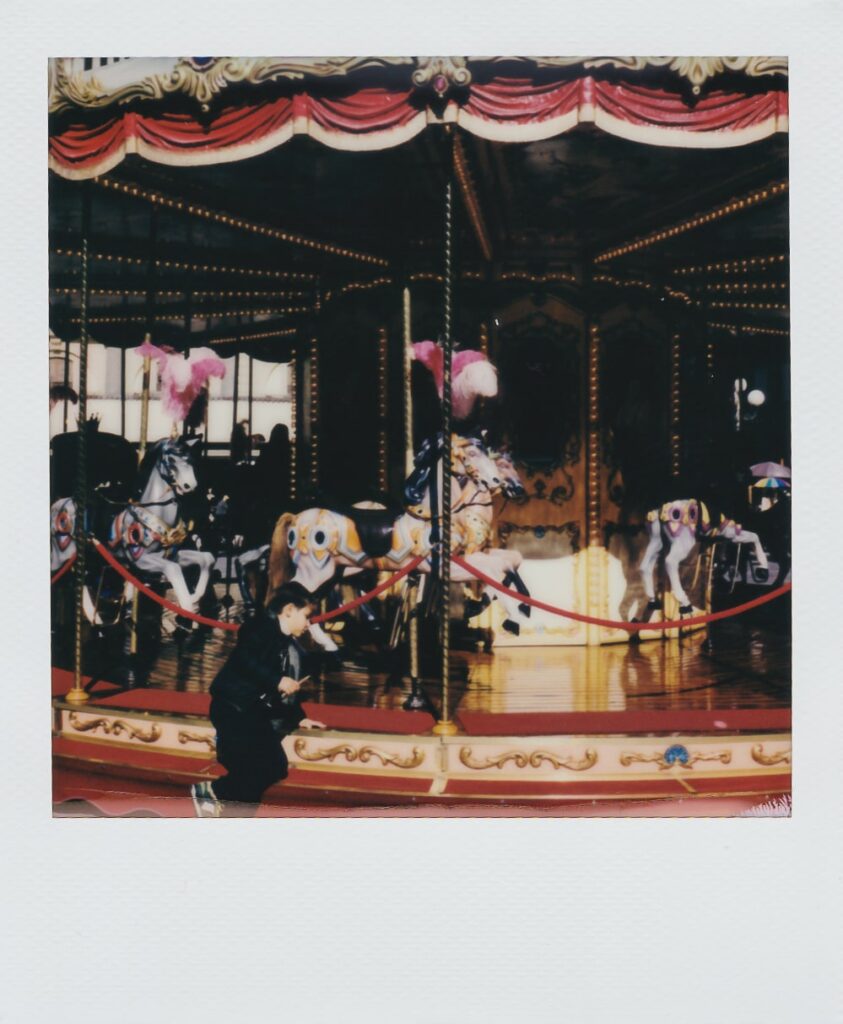
My Polaroid SX-70 settings for this diary
In the previous edition of the Polaroid Diaries, I was frustrated with the lack of light in Germany. In Tuscany, though, I didn’t have such problems. The weather was lovely, and most of the days, it remained dry. The sun helped me to get plenty of good images.
If you’ve read my SX-70 review, you probably remember that I don’t bother about the exposure wheel when it’s sunny outside. I usually leave it in the middle and try to focus correctly. In the photos you see above, I only touched the exposure wheel twice: in the portrait of Chris and in Florence’s Duomo.
In Chris’ portrait, I thought of isolating his face from the background. The sun was very intense this time of the day, and I preferred to have his face isolated. Also, the flowers behind him give a nice local touch to the image.
On the other hand, I’m not satisfied with my choice to underexpose the Duomo. The image turned a bit dark for my taste, even though the details look good. However, if I could reshoot the photo, I’d probably keep the exposure in the middle or even overexpose it a bit.
As always, there’s no post-processing in any of the polaroids you saw. I just scan them, and apart from a +10 in sharpness for web optimization, there’s no other touch. Polaroids should always look like polaroids.
And that’s it with one more edition of the Polaroid Diaries and the Tuscan dream photos with the Polaroid SX-70 in Italy. Don’t forget to subscribe to the mailing list below if you want to see more polaroids, camera reviews, and tips.
*You can buy the newest (and freshest) films and Polaroid cameras directly at Polaroid’s official websites.*
The US Store | The EU store | The UK Store
**If there’s no availability on the official stores, search for second-hand SX70s on Amazon.
More Polaroids: The complete Polaroid diaries, My Now+ review & My Polaroid GO review
Pin it for later

Sharing is caring. Share on FB or Twitter the Polaroid Diaries: a Tuscan dream.
Last Updated on February 4, 2023 by George Pavlopoulos


Some great photos here. That one of the Piazza Grande (cafe pic) amazes me for some reason. There is so much depth to it, and everything looks very clear. What did you focus on to take the pic?
Thanks, John. So glad you like the polaroid from Piazza Grande: I was hesitant to include it in this diary. I used infinity focus and tried to stand a few meters away from the first object. I wanted to have everything in focus, even though the light was relatively poor at the moment. But I’m glad you like it because I wasn’t sure if the colors+setting looked good enough.
George, this is probably an ignorant question, but how do you do an infinity focus with an SX-70 camera? Does your SX-70 camera have a split viewfinder? I would have thought that you would have focussed on one of the vertical poles by using the split viewfinder. However, I can’t see how you could have taken a better pic of that cafe area, so whatever you did was the best thing to do.
Also, can you give me a tip for taking good portrait shots? Do you try and find a vertical line to focus? How do you focus on a person? Both of the photos with your friends in it turned out great. The photos I take seem to be more blurry.
John, your question is not ignorant at all. I have one of the oldest SX-70 cameras, and it, unfortunately, doesn’t have a split viewfinder. So, as you can imagine, it’s even more challenging to focus correctly. Add on top that the viewfinder is not totally clean, and you can understand that focusing can be difficult.
My SX-70 is not a Sonar model; therefore, I rely exclusively on manual focus. If you turn the focus wheel all the way to the right (I think), the camera is set to infinity focus. That said, you can have almost everything in focus (polaroids have limitations, hence the “almost”).
All that said, manual focus on Polaroid SX-70 is highly intuitive. By looking through the viewfinder and by turning the wheel left and right, at some point, you’ll see your subject being in focus (or: sharp enough). I know: a slight turn of the wheel might still show you your subject in focus. What to do then? Here’s the intuitive part. I guess you’ll then depend on your instant gut feeling and hope for the best.
I think it takes trial and error, John. Honestly, in the photos you see of Chris and Marianna, I did exactly that: I played a bit around with the focus until they seemed sharp enough through the viewfinder. Especially for Chris’ portrait, I went really close to him, perhaps less than an arm’s length. Marianna’s photo (I wouldn’t really call it a portrait) is a bit more distant. The best portrait tip I can offer is to go as close as possible to your subject, have a light source behind you (preferably the sun), and take your time to focus correctly. The photo might feel too staged, but polaroid cameras don’t have very fast shutter speeds.
Did you try shooting a polaroid on a sunny day (preferably late afternoon), with the sun behind you and being close to your subject?
I haven’t tried to take a photo of a person closer than say 3 meters to the camera. I will have to try getting closer when the next opportunity arises. The problem with the sun is that you usually want to take a pic of people with a specific background behind them. For instance, a few weeks ago, I was at a cafe with a few guys (for a reunion). When we left, I wanted to take a pic of 4 guys in front of a sign, “Hey Jupiter,” a popular cafe. At the time, I was going to take full-body shots so that everyone would be fully in the pic. But I didn’t realize that I had no film left 🙁 We will be meeting again in a couple of months. I am now thinking that I should take a closer photo. Get their top half in the pic with the sign in the background. Not sure what the sun will do on the day. If the sun is out, it will be behind me, but there are buildings behind the camera as well, so they may create shadowy areas. Thanks for the SX-70 photo tips. I will have to try out an infinity focus for myself at some stage.
Sounds good. Even if it’s cloudy, make sure to have the sun behind you. The SX-70 is slightly limiting in certain aspects, but the results can be rewarding. If you’d like to experiment with portraits, you can shoot an object up close. It doesn’t matter what it is, just something that you think it’ll look good on a polaroid photo.
Also, the shadowy areas might offer you some negative space that’ll make your portraits pop (like the one from Chris). One of the polaroid limitations is that you can either have highlights or shadows. I think it makes more sense to focus on the highlights for a portrait. Anyway, enjoy shooting, and let me know how it goes!